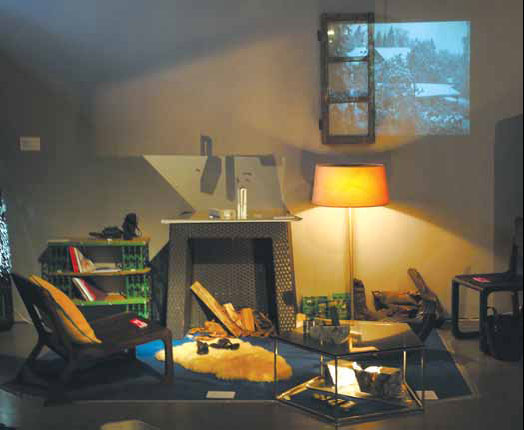
A living room with upcycled furniture and decorations is displayed at EMGdotART center in Guangzhou, Guangdong province. Photos Provided to China Daily
From a distance, it looks like a crystal chandelier. Take a closer look and one will notice that the "bulbs" are actually toothpaste tube covers.
It is not the only upcycling item with aesthetic appeal on display at an exhibition in Guangzhou.
Used tires are transformed into shoes, rocking horses and flowerpots, and a film reel is turned into a fashionable bag handle.
Upcycling is the process of converting waste materials or useless products into new materials or products of better quality.
"It prolongs the life of the material or product by giving it new, better values," says Zhang Jun, vice-director of the industrial design department of Hunan University.
"Recycling, however, is actually 'downcycling'. For example, the plastic recycled from a mineral water bottle cannot be used to make containers of drinking water because of the chemicals added in the process of recycling. It can be used to make buckets of lower sanity requirement."
The term upcycling first appeared about two decades ago in the West.
Upcycling has enjoyed rapid development in the past three years, widely applied in the small artisan sector in Europe and the US, according to Angus Bjarnason, director of British Council Guangzhou Office.
For example, the number of products on Etsy.com, a US e-commerce site, tagged with the word "upcycled" increased from about 7,900 in January 2010 to nearly 30,000 a year later - an increase of 275 percent. In April 2013, that number increased by a whopping 879 percent to 263,685.
In China, upcycling is unknown among the public and lacking in commercial application. But both Zhang and Bjarnason believe in the development potential of upcycling.
"China is the world's factory, a powerhouse of manufacturing industries. There is a lot of industrial waste and leftovers waiting to be upcycled," Zhang says.
"And traditional Chinese culture promotes a thrift lifestyle of reusing old objects. For example, parents will save their elder children's clothes for the younger ones to wear."
Bjarnason points out that upcycling is a way of life in developing countries without people knowing it.
"Africans have great craftsmanship in making handicrafts from all kinds of materials. But they don't know they are actually upcycling the materials. They haven't realized the business potential of these upcycled products," Bjarnason says.
Besides public education about upcycling, designers also need to come up with appealing creations.
Yang Wenqing, associate professor at the College of Design and Innovation of Shanghai-based Tongji University, cites Freitag bag, a Swiss brand known for bags made of truck canvas and car seat-belt, as a good example of a successful upcycling industrial design.
The professor has seen in Freitag bag the potential of turning upcycling into big business. Bags are priced at more than 1,000 yuan ($160) each but is commonly seen in Switzerland.
To raise awareness of upcycling, the cultural and education section of the British embassy in China launched an annual international competition of upcyling designs of industrial waste and leftovers last year at Guangzhou Academy of Fine Arts, in collaboration with the country's universities and Guangzhou Low Carbon Industry Association.
The competition is a platform where Chinese and UK college students and teachers demonstrate their creativity and provide possible solutions for a low-carbon economy.
This year, 32 students and 16 teachers from six UK universities, 10 Chinese universities, and one South Korean university participated in the event in Changsha, Hunan province, in May. The exhibition at EMGdotART center in Guangzhou's Redtory art area comprises selections of their designs. The creations are on display until June 23.
xujingxi@chinadaily.com.cn

